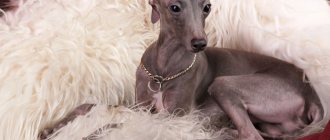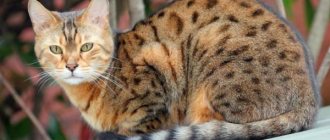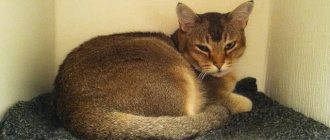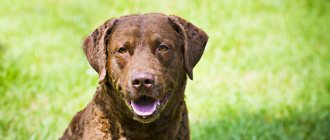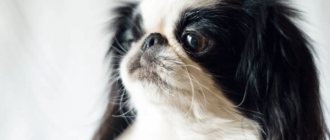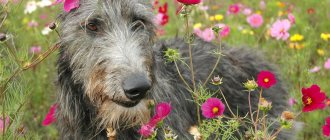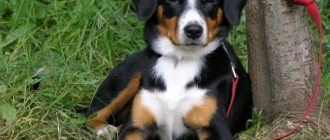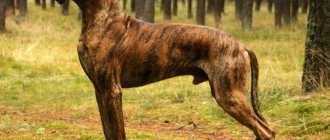Breed characteristics
| Short description | |
| Origin: | Switzerland (mountainous regions) |
| Conditions of detention: | In a country house with a large plot |
| Purpose: | Shepherd dog, guard dog, draft dog, companion dog |
| Color: | Black with bright red and white spots |
| Wool length: | Medium or short |
| Adult dog size: | The height of males is 65-72 cm at the withers, weight 54-70 kg, the height of females is 60-68 cm at the withers, weight 45-62 kg |
| Average life expectancy: | 11-12 years old |
| Walk: | Needed at least 2 times a day |
| Physical activity needs: | Medium – you need classes from 1 to 3 hours a day |
| Fédération Cynologique Internationale (FIC) classification: | Group 2: Pinscher and Schnauzer, Molosser, Swiss Mountain and Cattle Dogs; Section 3: Swiss Mountain and Cattle Dogs |
| Puppy price: | A pet for breeding and participation in exhibitions (show class) will cost 50,000-65,000 rubles, for breeding without participation in exhibitions (breed class) - 35,000-45,000 rubles, without the right to breed (pet class) – 25,000-30,000 rub. |
Appearance
The Swiss Mountain Dog group includes large and medium-sized animals. The group includes four varieties. They differ in size, coat length and other features. Life expectancy is on average 10-12 years. Swiss Mountain Dog - description of the breed:
- Bernsky. The height at the withers reaches 70 cm. This is a well-built dog with well-developed muscles. The main color is black. Long-haired variety. In a healthy dog it is silky, wavy and shiny. Brown markings are located above the eyes, in the belly area, around the anus and on the paws. White markings separate the head and muzzle, and there are stripes on the chest.
- Swiss Appenzeller Mountain Dog. Representatives of medium size. The maximum height at the withers is up to 58 cm. Moreover, the dog has strong bones and an almost square body. Light brown or black short coat. The Appenzeller has symmetrical markings on the paws, chest, under the eyes and in the belly area. They can be white or red-brown in color. The white line descends from the chin to the chest. The tail is always curled into a ring.
- Entlebucher. This is the smallest variety. The maximum size at the withers is 50 cm. Like other representatives of this group, it has a three-color color (red, white and black). The coat is short and shiny. This variety has a naturally short tail.
- Big. The largest dog of the Swiss Mountain Dog breed. One of the most common varieties in Russia. The height of the representative at the withers usually reaches 72 cm. It is distinguished by strong muscles and a powerful physique. The skeleton is very heavy, so the weight often reaches 65 kg or more. Despite this, Mountain Dogs are agile and energetic. It has a standard color - black, white and red.
In Russia, the most common breeds are the Bernese and Greater Swiss Mountain Dogs.
Their ears are drooping and usually black. Eyes – brown. There are different variations of shades possible - from light walnut to dark chestnut. The eye shape is almond-shaped. Everyone has a large, black nose.
Above is a description of the standards. Disadvantages include excessively short or long hair, and a violation of the color scheme. Club feet and blue eyes are also considered deviations.
History of the origin of the species
There are 4 breeds of dogs, united by the name “Sennenhund”: Bernese, Greater Swiss, Appenzeller and Entlebucher.
The first Sennenhunds appeared in Switzerland as a result of crossing local dogs with those brought by the Romans and Phoenicians (mastiffs, Molossians) and Germanic tribes (schnauzers, pinschers).
Mountain dogs have been in the service of people for a long time - they grazed herds in pastures, guarded yards, transported loads instead of horses, while guarding carts. Mountain dogs with their size, strength, intelligence, calmness and hard work were best suited for these purposes.
With the development of industry and agriculture, the need to use dogs disappeared, which led to a reduction in their number. Sennenhunds almost disappeared, but, fortunately, one of them became famous and gave birth to a fashion for their brothers. At the end of the 19th century, the Swiss Cynological Society began breeding tricolor Sennenhunds with different coat lengths.
By the beginning of the twentieth century, representatives of the Greater Swiss Mountain Dog species still remained, but there were very few of them . In 1908, a pair of them were noticed by a famous breeder, Professor A. Heim, under the name “short-haired Bernese Mountain Dogs.” Since that time, work began on searching for surviving populations and breeding purebred individuals.
The Greater Swiss Mountain Dog was recognized as a separate breed in 1909. The first club for lovers of such dogs appeared in 1912. It was only in 1939 that the first standard was published, and in 1956 individuals with modern colors according to the standard were bred.
A significant increase in the number of representatives of the breed occurred towards the end of the Second World War. They showed their best side during the war, doing an excellent job in the mountains delivering military cargo. Since then, the number of dogs belonging to this species has increased, but this breed remains not very well known and widespread in the world.
Distinctive features
According to the standard, the Greater Swiss Mountain Dog should look like this:
- The head tapers towards the muzzle, large and wide. The width of the muzzle is 2 times less than the width of the skull, the length is equal to the length of the skull. The furrowed forehead smoothly transitions into the bridge of the nose.
- The jaws are strong. Lips are black, not drooping. Full, scissor bite. The absence of premolars is allowed.
- The nose has a flat back, without a groove. The nose is large, protruding, black, large.
- The eyes are small, almond-shaped, of various shades of brown, not protruding or depressed.
- The ears are triangular in shape, flat, set high, close to the head. They can rise and turn forward towards sound.
- The neck is not too long, strong, without folds.
- The body is rectangular with a long and wide croup, slightly tucked sides and belly. The chest is wide and quite powerful.
- The tail is thick, slightly curved upward, but not curled. Usually hangs down, may be raised slightly above the croup, but does not hang over the back.
- The paws are muscular, smooth, widely spaced parallel to each other. Dewclaws should be removed from the hind legs.
- The coat is of medium or short length, with thick topcoat and dense undercoat, always black or dark gray.
- The color consists of three colors. The color is predominantly black and there are a few russet and white spots. Red spots are located on the superciliary ridges and inside the ears, under the tail; They are also located next to the white spots on the muzzle, on the front of the chest, and on the bottom of all four legs. The tail ends with a small white spot. The requirement for spots is symmetry.
- The character is calm and friendly.
All significant deviations from the traits inherent in the breed are considered obvious defects and are assessed according to the degree of severity. Particularly serious defects lead to disqualification.
Breed standards
— The head of Sennenhunds is large, wide, but harmonious in relation to the body. It has the shape of a blunt wedge. The lengths of the forehead and muzzle are equal. The back of the head is weakly expressed. The forehead is wider than the muzzle, flat with a noticeable furrow. The descent to the bridge of the nose is smooth, the bridge of the nose is smooth. The mouth is deep. The lips fit tightly to the gums and do not sag; their outer line is black.
- Teeth - medium-sized, strong, with a scissor bite. It is possible that the first and second molars behind the canines are missing - this is not considered a violation of the standard.
— The nose is moderately large, protruding beyond the jaw line. The skin is black.
- The eyes are small. The planting distance and depth are average. The shape of the eyes is round, the inner corners are slightly lowered towards the nose. The eyelids are raised, but completely cover the whites. The eyeliner is black, without any other color spots. Iris in brown shades. The dog looks expressively, intelligently and warily.
— Ears are dense, triangular, adjacent to the head. When the Mountain Dog is focused, they are raised and turned forward.
— The body is rectangular, but not elongated. Weight is proportional to height and width. Legs don't seem long. The neck is powerful, medium in length and smoothly turning into an inconspicuous withers.
— The back is wide, strong, muscular. The muscles are well defined. The depth of the chest reaches to the elbows, and the ribs are moderately rounded, stretched back. The sternum has a regular oval shape, the keel bone does not protrude. The croup is in line with the shoulders, smoothly transitioning into the hips. The stomach is toned, but not dry. There are no folds or “loose skin”.
— Paws — powerful, even, rather dry. The line of the forelimbs is longer than the line of the hind limbs. In the stance, the latter are slightly pulled back, the knees are almost straight. Elbows are parallel to the axis of the body.
— The thigh muscles are well developed, the hock joint is strong and set at a natural angle. The hands are powerful, rounded, and the fingers are curved and compressed. The claws are meek and dense. The paw pads are covered with thick skin and painted black.
— The tail is wide, strong, of natural length. It is kept low, at the level of the ridge or higher. It may be slightly curved, but does not curl into a ring.
— The coat is short, semi-rigid with a dense structure and undercoat. The color of the latter varies from the preferred black to gray. A distinctive feature is the tricolor color: a shirt of a rich black shade, white and red spots, which should contrast sharply.
It is necessary to have red spots above the eyes, which should be clearly visible and should not merge with the T-shaped white spot on the muzzle. Males and females are visually well distinguished from each other. Females are smaller: 60-68 cm at the withers than males: 65-72 cm.
Photo of an adult dog
Photos of puppies
Features of character and behavior
- Greater Swiss Mountain Dogs have strong guard instincts and the skills of a working draft dog . Without regular exercise and communication with people, the dog’s character will deteriorate, but doing familiar work will allow him to show everything he is capable of.
- Representatives of this breed love water and enjoy swimming in ponds.
- Due to their non-aggressive nature, Mountain Dogs are often kept as family dogs . They enjoy playing with children.
- Large Swiss Mountain Dogs clearly distinguish between friends and foes ; they will not touch other pets, but will drive neighbors away from their territory. They also bark at strangers, but they are ready to welcome those who come to visit their owner.
Advantages
- Greater Swiss Mountain Dogs have a balanced and peaceful disposition and are patient, especially when properly trained. At the same time, they are active, inquisitive and clean.
- These dogs become very attached to the owner and his family members and enjoy spending time with them. They are friendly towards guests, affectionate in their interactions with children, and tolerant of other animals.
- Greater Swiss Mountain Dogs have well-developed guarding qualities , and they usually respond to various sounds by barking, but they rarely resort to aggression - only when they decide that there is a real danger.
Flaws
- The flip side of the Greater Swiss Mountain Dog's calmness and equanimity is their stubbornness . They may sit or lie on the ground and refuse to obey commands.
- Their maturation period lasts longer (up to 2 years) , when the dog is adult in appearance and size, but its behavior remains like that of a puppy. Out of joy, a mountain dog can jump on a person's chest and knock him down.
- If you do not pay enough attention to upbringing, communication and getting to know others, the dog may develop aggression, a desire to dominate family members, or, conversely, fearfulness.
Character
Dogs of this breed, undoubtedly, each have their own, individual character. Each dog is unique and unlike any other, but they are characterized by certain traits that are genetically inherent in representatives of all Swiss bloodlines.
Basically, all Mountain Dogs are highly trainable and actively participate in the training process. At the same time, they love activity very much, but often show stubbornness and even disobedience.
Moderately calm, without bright emotional outbursts. Devoted and true friends. They treat all family members with respect, love and respect the owner. They love attention, games, running, adore their owner, and can become sad when he is absent for a long time.
- With good training, the dog's behavior can be corrected; they have a strong protective instinct, which sometimes interferes with simple life in the family.
These are very vigilant guards, capable of quickly and easily entering into battle, and will never attack without reason, and will also promptly warn ill-wishers with a loud bark. Grosses often mistake any extraneous sound for danger, so you will have to listen to barking often.
They are dangerous opponents, fearless, brave and fast. Adult dogs are patient with small children, but until they grow up, it is better not to leave them without supervision with the child, and also instruct the baby himself, explaining what is permissible to do with the pet and what is prohibited.
They get along with other pets, but their absence is preferable; it is not recommended to keep two males, otherwise constant clashes between them are guaranteed. Representatives of many breeds are capable of behaving like dominants, especially males - Doberman Pinschers, Boxers and many others. This does not mean increased aggression, but you should always be on guard.
- Girls have a more serious calmness, sometimes even detachment, while the thirst for communication does not take a back seat.
Care and maintenance
The Greater Swiss Mountain Dog is not very convenient to keep in a city apartment due to its size and protective instincts. A booth in the spacious garden of a country house with the ability to move freely around it is ideal for him to live in.
An enclosure or chain is not suitable for such a dog - it needs to move a lot every day, exercise and communicate with its owner, and when alone it can become aggressive and uncontrollable.
Your pet must have a place to sleep, dry, not windy, with soft bedding, and periodically cleaned.
The Mountain Dog, like most dogs, requires simple care for its eyes, ears, teeth and nails:
- Eyes and ears should be examined daily. Gently wipe off any discharge or dirt that appears in the corners of the eyes with a cotton pad soaked in warm boiled water. Chamomile decoction or weak tea can cause allergies, so they are not suitable. Wipe your ears with baby oil or Vaseline oil or a special cleaner if they often become inflamed. If you find pus in your dog's ears or eyes, you need to contact a veterinarian.
- To prevent tartar, your dog should be given soft cartilage or edible cleaning sticks. You can brush her teeth with a toothbrush and dog toothpaste. Only a veterinarian can remove tartar.
- Dog paws should be washed or wiped with a damp cloth after each walk , especially between the toes, and the paw pads should be inspected to see if they are damaged. A dog that lives in the yard and frequently walks usually wears its nails down on its own, but periodically checking the length won’t hurt. If the nails are overgrown, they will need to be trimmed yourself or by a veterinarian.
Nutrition
For large dogs like the Greater Swiss Mountain Dog, a nutritious diet is important. An unbalanced or excess diet can cause problems with the gastrointestinal tract, joints and bones.
A small puppy needs to be fed 5-6 times a day; as it grows, this number gradually decreases to 1-2 times. Food should be placed in a clean bowl at approximately the same time, and drinking water should be freely available.
If the dog is fed natural food, its diet will be dominated by raw meat, which should be given chopped and scalded. It is also important to include in your dog’s diet:
- boiled offal (tripe, liver, tongue, kidneys, heart, etc.);
- porridge from various cereals, cooked in water or meat broth;
- raw or boiled vegetables, fruits and berries in small quantities;
- dairy products without additives and cheese.
If you prefer dry food to feed your pet, you need to choose high-quality food intended for large breed dogs.
Flour, sweets, dishes from your own table, and tubular bones should not be given to the dog. Bone meal and vitamin-mineral complexes should be used as food enrichment additives.
Health
The Greater Swiss Mountain Dog is a hardy dog, has good health and has a strong enough immune system to protect against various infections. And yet, due to its large size, it is characterized by a short life expectancy - 11-12 years with proper care.
As a result of selection, a tendency to certain diseases is “written” in the genes of the breed, which can manifest themselves in individual representatives. An experienced veterinarian can help monitor your dog's health.
- To prevent the appearance of worms, your Sennenhund should be regularly given an anthelmintic drug. For a puppy, the first time the procedure is performed at the age of 3 weeks, and then up to 1 year, and he is wormed at least once every 3 months . An adult dog needs to be dewormed at least once every 6 months , but if it eats natural food, the frequency of the procedure increases to once every 3-4 months .
- Usually the anthelmintic drug is given once. If parasites, vomiting, or diarrhea are detected in the dog’s feces, deworming must be done again after 10-14 days to remove the worms that hatched from the eggs during this time.
- After walks, you need to inspect the dog’s fur for ticks and, if any are found, contact a veterinarian. You should once every 2-3 months with shampoo against skin parasites and use special preparations and collars to prevent their appearance.
Vaccinations
The dog must be vaccinated promptly from an early age. Vaccinations are given against diseases such as hepatitis, rabies, parvovirus enteritis, distemper and leptospirosis. It is better to entrust this action to a veterinarian.
Before any vaccination, you should make sure that your pet is healthy. Vaccinations are placed at the withers (subcutaneously) or in the thigh (intramuscular).
- The first vaccination is carried out at 2 months against plague and enteritis, the next one – after 3 weeks . After vaccination, the puppy must be protected from drafts and contact with other animals for 12-14 days (do not walk), do not wash and do not give food more than normal. During this time, immunity will be formed. The first vaccination is the most difficult to tolerate; in the first days after it, the puppy may experience lethargy, increased body temperature, and loose stools.
- At 6 months of age, the child is vaccinated with a rabies vaccine and a polyvalent vaccine against other diseases . A contraindication to vaccination is changing baby teeth. Vaccination should be postponed until completion.
- At 1 year of age, a polyvalent vaccine is given, then it needs to be given once a year.
All vaccinations completed are included in the dog’s passport, which can be used to determine the date of the next vaccination.
Diseases
Greater Swiss Mountain Dogs are predisposed to certain inherited diseases, such as:
- distichiasis, entropy;
- cataracts and retinal atrophy;
- osteochondrosis and joint dysplasia;
- allergies, dermatitis;
- diseases of the gastrointestinal tract, obesity;
- heart diseases;
- tumors of different types;
- urinary incontinence.
Walk
- The Greater Swiss Mountain Dog needs frequent exposure to fresh air. Even if he constantly lives in the yard, he will need additional regular long walks without a leash with outdoor games, sports, and sled riding.
- You need to walk your dog 2 times a day, each walk should take at least 1 hour. If the pet lives in a city apartment, then the length of walks increases to 1.5-2 hours.
- In summer, the Mountain Dog needs shelter from the heat - with its black coat and dense undercoat, it is easy to get overheated and heatstroke.
Grooming
Caring for the short coat of the Greater Swiss Mountain Dog involves regular brushing with a stiff-bristled brush or a Furminator (1-2 times a week). Twice a year, these dogs actively shed, and they need to comb their hair once every 1-2 days , especially on the neck and chest.
A dirty dog can be bathed, but frequent washing is not recommended.
Health and life expectancy
In general, Greater Swiss dogs are very strong and resilient, have good immunity, are resistant to stress and easily adapt to new conditions. But selection work has left its mark on the breed in the form of a number of hereditary diseases:
- Dysplasia of the elbow and hip joints;
- Osteochondrosis;
- Entropion;
- Retinal atrophy;
- Cataract;
- Allergy;
- Oncological diseases.
This does not mean that one dog will have all these diseases. They may not exist at all. It’s just that all these pathologies and diseases are most often found in representatives of the breed. Part of proper dog care should include routine vaccinations and regular treatment against external and internal parasites. Life expectancy is usually 10-12 years.
Mating
- The age of the first heat in female Greater Swiss Mountain Dogs is 11-12 months. Further, estrus occurs 1-2 times a year and lasts for 3 weeks. External signs of estrus are swelling of the loop and bloody discharge from it.
- It is advisable to mate a male for the first time when he is 2-3 years old , before interest dies away. It is better to start breeding a female no earlier than 2 years . To get puppies, you need to breed dogs on the 11-15th day of the female's heat.
- After the dogs have met, the female is taken to the male’s territory for mating. Usually animals cope well on their own, but if problems arise, a specialist will help. Once again mating is carried out 1-2 days after the first .
- Pregnancy lasts 56-72 days . This period is worth tracking in order to have time to help the dog during early or late birth.
Key points in training
Greater Swiss Mountain Dogs are very intelligent, they respond well to training and quickly learn commands, especially when performing monotonous tasks. By raising and socializing your dog from an early age, you can make it obedient and friendly.
Training will only be effective if the owner makes the dog understand his position as a leader. Otherwise, the dog simply will not obey, and you need to contact a professional dog handler to correct its behavior.
When training, you should not raise your voice at your pet or cause physical pain to it. The owner is required to have self-confidence, composure and concentration, and maintain contact with the dog. Commands must be clear and understandable; after they are completed, the dog receives praise.
Read about how to properly train a dog in the article: “Training a puppy: effective methods from dog handlers, learning commands at home.”
The Mountain Dog may become stubborn and refuse to follow a command, in which case it is worth showing patience and perseverance. When keeping a large Swiss Mountain Dog in an apartment, you will have to pay great attention to weaning it from barking indoors.
Education and training
Active training with a Swiss Mountain Dog begins at 7-9 months, since it is at this age that the puppy’s growth ends. You should not overload a pet that is not yet six months old, as this can lead to disruption of the animal’s development.
Dogs of this breed respond well to training, but they do not tolerate too harsh handling. A lack of positive emotions and an excess of negative reinforcement during the training process can lead to the pet completely refusing to make contact.
How to choose a puppy
The uniqueness and beauty of the breed should not be the reason for choosing it, because raising and maintaining such a large dog will require a lot of time, attention and patience from the owners.
- You should not try to save money on your purchase. Purchasing a puppy without documents, from an unverified nursery, often means that it does not correspond to the breed qualities, the risk of having a disease, etc.
- You need to find trusted nurseries and experienced, well-known breeders . It may also be worth talking to people who have previously purchased puppies from this breeder.
- You can judge a puppy’s health by its appearance - it’s good if it has clean fur and eyes, a wet nose, and is active and curious. Puppies should be kept in good conditions: no strong unpleasant odors, dirt and debris on the floor and where the dogs sleep.
- The most suitable age to adopt a puppy from a kennel is 2-6 months. An older dog will be less able to bear parting with the breeder.
The Greater Swiss Mountain Dog will be a reliable guard and loyal friend for active people and large families with children. If the owners are ready to devote a lot of time to communication and raising their pet, they will have a calm, intelligent, strong, friendly dog, a real source of pride.

